Attracting Wildlife
The garden, orchard and meadow, in 2010, host about 160 indigenous species of plants including: 126 species of Wildflowers In addition to the natural attractions of the soil and plants on site, we provide food and additional 'facilities' to attract and assist wildlife to visit, nest or shelter. |
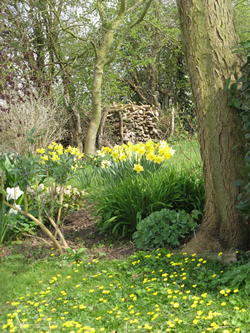 |
Attracting Birds |
|
A bird table with mixed seeds, a peanut feeder and a seed feeder. The basic bird table and accessories are "Droll Yankee" with the large plastic seed tray deterring squirrels from getting to the food. To deter crow and magpie visits to the bird table, a hanging basket has been upturned and a hole cut in its wiring to allow the pole to fit through it. It has been very effective. The picture shows a Squirrel, a Pheasant, a pair of Mallards, a Starling, a Finch and a Great Tit all congregating for a late Spring feed. Bird Food is sourced from Vine House Farm which provides a range of good bird foods, free next day delivery and donates 5% of its revenues to the Wildlife Trusts. It is the best I have used and the birds are very happy. |
|
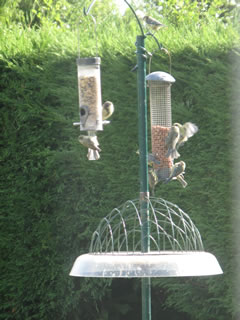 |
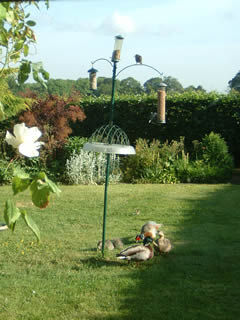 |
| In 2009 a 3-home Sparrow Terrace was placed high on a house wall above a Clematis which has climbed over and obscured the box, but for the first time in 6 years, Sparrows have returned and bred in the terrace box. | 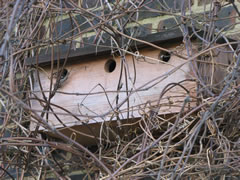 |
| Four Bird Baths are located in the Back Garden and Orchard and are topped up daily during the summer providing water for both birds and insects for drinking and bathing. Some are on the ground and are popular with the Mallards and some on a pedestal. All have been popular and appreciated by the birds (and hover flies) in the dry summer of 2010. | 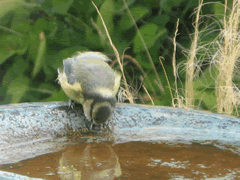 |
| Roosting Pockets are made from woven reed and provide a reasonably waterproof and wind-protected place for a bird to roost overnight. Several have been placed around the garden and have been used. They deteriorate and de-compose in a year or two if wet. Under the eaves they are dry, lasting well and proving popular. |  |
| Seven Bird boxes, made of wood, some home-made, some shop-bought are located in hedges, bushes, on the garage eaves and in the front porch. Usage varies each year with one or two used annually and others intermittently. | 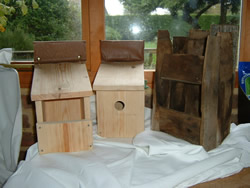 |
| In Spring, Nest Building materials are put in hanging baskets and hung under the Juniper. The birds have a selection of materials to choose from including straw, hay, combed dog hair and this year, sheep fleece from the sheep in the adjacent field. It las proved to be a popular attraction in Spring. | 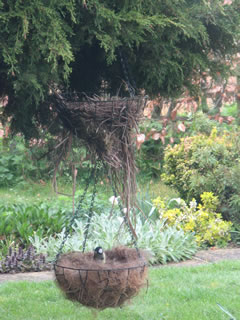 |
| A hanging fruit or fat ball holder. A fat ball or apple can be skewered through the circular opening or as shown with a coconut fat feast attached. This fat 'ball' has proved particularly appealing to a group of 7 or 8 long-tailed tits. |  |
Attracting Mammals |
|
| Two Hedgehog Boxes home-made from a wooden pallet and some old lap fencing. Filled with some autumn leaves and straw they were made in 2008 and placed along the hedgerow about 35 yards apart. The design allows a side wall to be opened to view the inner chamber, but in retrospect it would have been easier to have a removable roof to view the chamber. As a result it is difficult to tell if they have been used, but they are there, correctly designed to be most suitable homes for hedgehogs. After several year of not sighting them, hedgehogs have been sighted in the garden in both 2009 and 2010 so its quite possible they are being used for hibernation. |  |
Attracting Insects |
|
| A Bee and Insect House has been hung on a south facing wall. It is a shop-purchased house full of bamboo cylinders with a metal roof. |  |
| Insect nesting tubes. A bunch of old bamboo canes tiled up with wire and strung (along with an old brush head) from the eaves of an outbuilding, is being used by a variety of insects and spiders. | 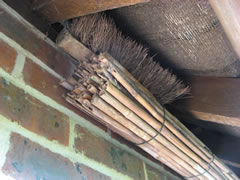 |
In 2008 a Bumblebee nest was constructed to a Bumblebee Conservation Trust design. Nobody has moved in yet but it's a facility that will be most attractive when discovered. Golf balls are used to keep the 'lid' raised to allow excess heat out. Further enhancements will be made to this design.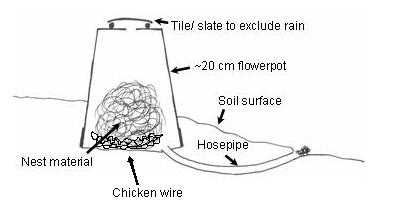 |
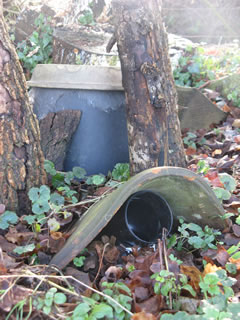 |
| A Ladybird Tower has been placed in the warm and sunny front porch of the house. While looking most attractive, it is clearly not as warm and sheltered as the wooden window frames of the house that have been filled with 'alien' Harlequin ladybirds who have over-wintered there for the last few years. | 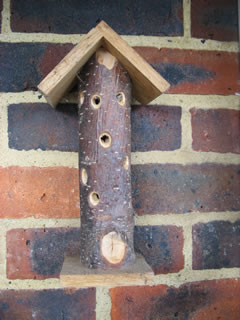 |

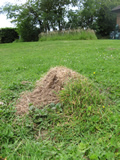 Our most important provision is an organic, chemical-free 2-acres of soil. The soil determines the plants that grow and in turn the plants attract the various creatures to feed, nest or shelter. A healthy soil itself provides habitat for a huge number of insects, mammals and micro-organisms so our care of it since 1995 is the very foundation of a wildlife-friendly environment and a healthy and active food chain.
Our most important provision is an organic, chemical-free 2-acres of soil. The soil determines the plants that grow and in turn the plants attract the various creatures to feed, nest or shelter. A healthy soil itself provides habitat for a huge number of insects, mammals and micro-organisms so our care of it since 1995 is the very foundation of a wildlife-friendly environment and a healthy and active food chain.